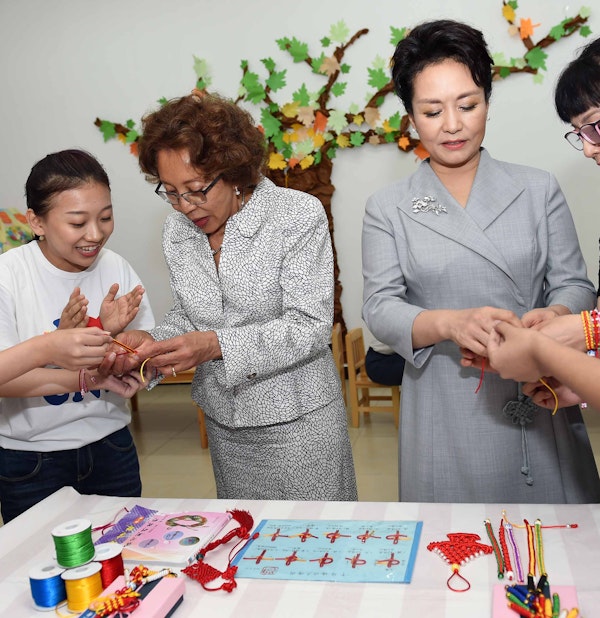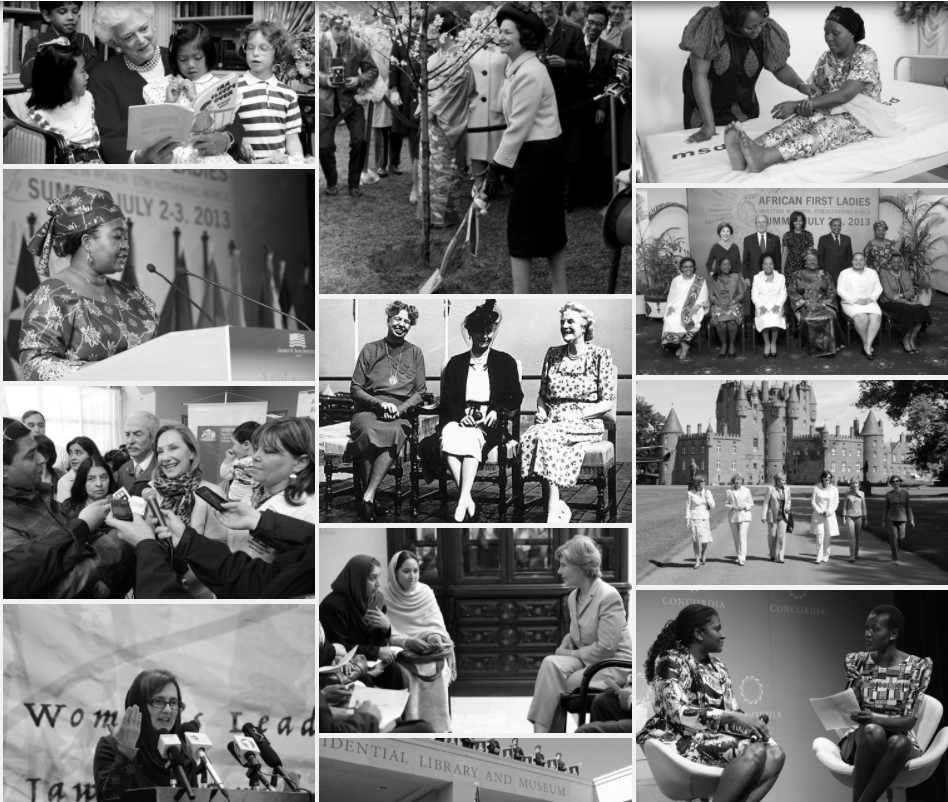How to Win Allies and Influence People: The Case of China in Africa
The United States and China have different approaches — and aims — when it comes to foreign aid, which is evident in their relationships with African nations. The result? A shift in influence on the African continent.
 Senegal's Chinese-aided Children Hospital of Diamniadio celebrates the donation of medical supplies to the hospital in June 2020. (Xing Jianqiao/Xinhua via Getty)
Senegal's Chinese-aided Children Hospital of Diamniadio celebrates the donation of medical supplies to the hospital in June 2020. (Xing Jianqiao/Xinhua via Getty)
While the struggle for status among the world’s leading powers has been playing out for centuries, over the last decade, China has swiftly doubled down on their push for influence abroad. Amid waning U.S. engagement, China has seized on the current void, winning favor, making strategic investments, and influencing power dynamics through the increasing use of soft power. This is especially clear on the continent of Africa.
The Role of Development Aid to Influence
Not surprisingly, the U.S. and China have very different models for development aid.
For the U.S., transparency, accountability, good governance, and protection of human rights are critical components of foreign assistance engagement.
For China, its approach is often centered on benefits to China. Though they have limited restrictions and a more expansive definition of what foreign assistance encompasses (including economic development and security initiatives), China asserts strict control over how aid is spent.
Moreover, China’s “no strings attached” approach has raised concern over human rights abuses. Governments who have a questionable track record on democratic values are not held to account, and basic human rights and freedoms are not guaranteed.
For both the U.S. and China, the last 60 years saw a steady increase in engagement with countries across the African continent. But the last two decades stand out as particularly important.
Before his administration, President Bush notes in his book Decision Points that most aid to Africa had been continuations of Cold War efforts to support anti-communist governments, but were doing little more than helping keep preferred administrations in power. Even before he ran for the office, President Bush determined that Africa would be a key part of his foreign policy. Establishing programs like the President’s Emergency Plan for Aids Relief (PEPFAR) in 2003, the Millennium Challenges Corporation (MCC) in 2004, and the President’s Malaria Initiative (PMI) in 2005, President Bush acted on his intention. From 2000 to 2008, U.S. aid to Africa increased rapidly.
As the U.S. expanded its engagement with Africa, individuals, communities, and countries at large were impacted. Due to PEPFAR, 18 million lives to date have been saved. Since 2006, where PMI has invested, malaria cases have decreased by 27% and deaths from malaria have declined by 60%, and MCC’s programs have made progress across a variety of development indicators. But, the foreign aid investments the U.S. infused into the continent also wielded soft power for broader outcomes: better economic partnerships, friendlier diplomatic relationships, and increased democratic values.
China’s Focus on Africa
Not long after the U.S. ramped up its presence in Africa in the early 2000s, China followed suit. While China has been providing foreign aid for decades, it has significantly increased investments in recent years.
Not long after the U.S. ramped up its presence in Africa in the early 2000s, China followed suit. While China has been providing foreign aid for decades, it has significantly increased investments in recent years.
China does not disclose its foreign aid spending so estimates are hard to track. A study published in BMJ Global Health estimated China’s development aid for health nearly doubled from $323.1 million in 2007 to $652.3 million in 2017. However, differences in how China defines aid and lack of transparency mean that estimates may vary widely.
 Uganda President Yoweri Museveni (R) and China's Third Vice Prime Minister, Wang Yang celebrate the Chinese-funded 51-kilometer expressway linking the capital city and the international airport in Entebbe, Uganda, in 2018. (Sumy Sadurni /AFP via Getty Images)
Uganda President Yoweri Museveni (R) and China's Third Vice Prime Minister, Wang Yang celebrate the Chinese-funded 51-kilometer expressway linking the capital city and the international airport in Entebbe, Uganda, in 2018. (Sumy Sadurni /AFP via Getty Images)
Its Belt and Road Initiative (BRI), a global infrastructure project launched by President Xi Jinping in 2013 to benefit China’s growing economy, often masquerades as a large scale development project, but as the Council on Foreign Relations points out, “skeptics worry that China is laying a debt trap for borrowing governments.” As a complement to the BRI, China has also increased its investments in health infrastructure, signing an agreement with the World Health Organization (WHO) in 2017 to create a “Health Silk Road” to support progress toward the 2030 SDGs in developing nations.
On trade, as China strengthens relationships in Africa, the U.S. loses out. China has been Africa’s top trading partner for over a decade. A Congressional Research Service report noted that, “total China-Africa trade surpassed that of U.S.-Africa trade in 2009, and in 2017, at $137 billion, was 3.5 times as large as U.S.-African trade.”
On trade, as China strengthens relationships in Africa, the U.S. loses out. China has been Africa’s top trading partner for over a decade.
Notably in 2017, the Chinese People’s Liberation Army officially opened the country’s first overseas military base in Djibouti, also home to American and French bases.
China’s lending structures, which are described by some as predatory or “debt trap diplomacy,” have put African countries at risk of defaulting. With the economic implications of the COVID-19 pandemic, the concern has become even more immediate. Not only could the default mean an abrupt end to huge infrastructure projects, but the ability to pay for those projects and their upkeep becomes a concern. This is not to mention the common understanding that projects funded, managed, and built by the Chinese have been poor quality.
The Influence of Soft Power
Development aid and trade aren’t the only ways China is gaining ground in Africa. Shifting relationship dynamics through soft power are also helping China gain influence on the continent. The term soft power was first introduced by Joseph Nye in 1990. It refers to getting others to share your objectives through the presentation of one’s own culture, political values, and policy rather than through coercion. From education exchanges to cultural centers and foreign aid to high-level envoys including first ladies, countries have used soft power tactics for broader benefit.
Development aid and trade aren’t the only ways China is gaining ground in Africa. Shifting relationship dynamics through soft power are also helping China gain influence on the continent.
Though she is most widely known for her soft power influence in the context of U.S. engagement with China, Mrs. Pat Nixon’s influence on U.S.-Africa relations offers an important case study.
 President Richard Nixon and First Lady Pat Nixon visit the Great Wall of China, February 24, 1972. (White House)
President Richard Nixon and First Lady Pat Nixon visit the Great Wall of China, February 24, 1972. (White House)
During her 1972 visit to China with President Richard Nixon, Mrs. Nixon’s warmness resonated greatly in China. Her appreciation for her visit to Peking and subsequent discussions during one of the trip’s many galas marked the start of “Panda Diplomacy” and the tenure of China’s pandas at the National Zoo in Washington, D.C. Decades later, her vibrant red coat still stands as an icon of the historic visit.
But before she went to China, Nixon became the first American first lady to travel to the African continent. From Liberia to Ghana to Côte d’Ivoire, during her second solo trip abroad, Mrs. Nixon led bilateral discussions with political and traditional leaders, addressed national legislatures and international media, connected with local citizens, and offered gestures of American generosity. “[T]he first first lady to confer with presidents of foreign countries,” according to the Richard Nixon Foundation, her talking points included a focus on U.S. policy in Rhodesia and South Africa.
Her warmth and affection for the people she met and the countries she visited were hard to miss, benefiting both U.S.-Africa relations and the Nixons’ reputation back home. According to Pat and Dick: An Intimate Portrait of a Marriage, 85% of U.S. news outlets covered the first day of the visit, and President Nixon sent her a cable highlighting her success: “Everybody here believes sending you on the trip was a ten strike.”
 Mrs. Pat Nixon visits with a child in a hospital in Ghana, January 6, 1972. (White House)
Mrs. Pat Nixon visits with a child in a hospital in Ghana, January 6, 1972. (White House)
Her leadership and focus on relationship-building underscored the effectiveness of soft power. In the context of Africa especially, visits like Mrs. Nixon’s have increasingly become a norm — albeit in different ways. For example, during her time in the East Wing, Mrs. Laura Bush made five trips to sub-Saharan Africa largely in relation to the U.S. foreign aid programs, including PEPFAR, MCC, and PMI.
But nearly five decades after Mrs. Nixon’s tenure, similar soft power tactics have been embraced by China in its own vigorous engagement across the African continent. Their rapid success stands as yet another warning on the imperative for U.S. leadership and partnership abroad.
Stepping outside the limited and often hidden role occupied by her predecessors, Chinese First Lady Peng Liyuan has leveraged her podium in support of key diplomatic interests of the regime. Barely a year into her tenure as first lady, her early influence even earned her a place among TIME Magazine’s 2013 list of “Most Influential People”.
During their first international trip as President and First Lady in 2013, Xi Jinping and Peng Liyuan visited Russia and three African nations. TIME described the Chinese First Lady’s presence on the trip as a “one-woman charm offensive…humanizing the communist regime.” Garnering attention for her trendsetting and charismatic presence, Ms. Peng has been compared to influential peers, including fellow first ladies and royalty like the Duchess of Cambridge.
Since 2011, she has served as a WHO Goodwill Ambassador for Tuberculosis and HIV/AIDS . But perhaps most notably, she often stands as a key envoy for Chinese engagement abroad.
On the sidelines of the 2018 Forum on China-Africa Cooperation (FOCAC), which welcomed over 20 African Heads of State and First Ladies to Beijing, Ms. Peng hosted a thematic meeting on HIV/AIDS. The discussion included an announcement by the Chinese First Lady of “a three-year HIV prevention campaign among adolescents to begin in 2019 as well as a community health promotion program involving China, several African countries, and international organizations,” according to UNAIDS. Her advocacy work has also included leading the 2016 China-Africa Children Summer Camp (for children affected by HIV), regular engagement with international peers, and recognition from international institutions.
 First Lady of South Africa Ms. Tshepo Motsepe and Chinese First Lady Ms. Peng Liyuan tour the College of Pre-School Education at Capital Normal University in Haidian, Beijing in 2018. (GovernmentZA on Flickr)
First Lady of South Africa Ms. Tshepo Motsepe and Chinese First Lady Ms. Peng Liyuan tour the College of Pre-School Education at Capital Normal University in Haidian, Beijing in 2018. (GovernmentZA on Flickr)
And amid the 2020 COVID-19 pandemic, Ms. Peng has helped to lead the regime’s visible donation of medical supplies and equipment to 53 African countries, including infrared thermometers, face masks, and other personal protective equipment to support vulnerable populations.
In a number of countries, receipt of the items included a public ceremony to mark the handover of supplies, with emphasis on the China Communist Party’s commitment to safeguarding the well-being and rights of women and youth. Remarks cited the “warm relations” between the respective nations.
Why the U.S. Must Reengage
Given China’s increasing influence in Africa, it’s clear the U.S. must reengage.
Given China’s increasing influence in Africa, it’s clear the U.S. must reengage.
Although the U.S. has spent over $100 billion on development programs across the continent since 2000, funding has largely stagnated over the last decade, with American influence and relationships at stake.
According to early results from Afrobarometer on development model perceptions, 32% of respondents across 18 African countries said the U.S. had the best development model, followed by 23% of respondents who thought the Chinese model was better. Further, 59% of respondents said China’s influence is positive while 15% said its influence was negative. Asked about the U.S., 58% of respondents said the U.S.’s influence is positive and 13% said it was negative.
A recently-published qualitative study of perceptions from Tanzania and Malawi of China’s Health Aid to Africa found that while there was support for and value in Chinese health aid, there were also challenges. Recommendations as part of the study also offer insight to how the U.S. can build on its foreign aid partnerships to improve perceptions. This includes a greater emphasis on collaborative engagement, such as working with country-level technocrats to identify needs and sustainable solutions, collaborating with other partners to reduce duplication and increase impact, and building the capacity of national leaders to initiate and sustainably implement projects.
As Africa continues to grow in its economic and political influence, the U.S. may recognize less of its interests represented in the future of the continent unless relationships are strengthened and funding levels remain robust or improve.
The Catalyst believes that ideas matter. We aim to stimulate debate on the most important issues of the day, featuring a range of arguments that are constructive, high-minded, and share our core values of freedom, opportunity, accountability, and compassion. To that end, we seek out ideas that may challenge us, and the authors’ views presented here are their own; The Catalyst does not endorse any particular policy, politician, or party.

 The Bush Institute takes an in-depth look at the influence and leadership of first ladies around the world in A Role Without a Rulebook.
The Bush Institute takes an in-depth look at the influence and leadership of first ladies around the world in A Role Without a Rulebook.
